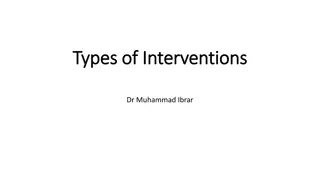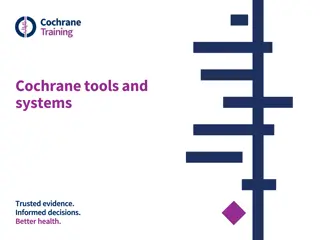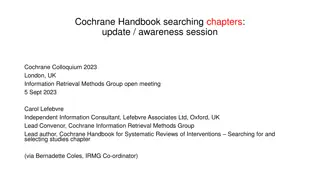Developing Brief Economic Commentaries for Cochrane Intervention Reviews
End-user decisions benefit from the inclusion of economic perspectives in Cochrane Intervention Reviews (CIRs). This summary explores the importance of incorporating economic evidence to enhance the applicability of reviews, without substantial additional resource burden. Topics covered include cost-of-illness studies, economic evaluations, and the proposal for brief economic commentaries to provide valuable insights into resource use and cost-effectiveness.
Download Presentation

Please find below an Image/Link to download the presentation.
The content on the website is provided AS IS for your information and personal use only. It may not be sold, licensed, or shared on other websites without obtaining consent from the author. Download presentation by click this link. If you encounter any issues during the download, it is possible that the publisher has removed the file from their server.
E N D
Presentation Transcript
Cochrane UK & Ireland Annual Symposium 2014 How to develop brief economic commentaries for Cochrane intervention reviews (CIRs) A Campbell and Cochrane Economics Methods Group Methods Training Workshop www.c-cemg.org
Background End-user decisions increasingly need to take account of evidence for resource use, costs, cost-effectiveness Economic perspectives and evidence are either absent from CIRs or injudiciously treated At best CIRs lack relevance and impact and at worst may mislead Extending CIRs to include economic perspectives and evidence can increase applicability for end-user decisions Shemilt et al. Cochrane Handbook Chp 15: Incorporating economic evidence, 2008. Lavis et al. J Health Serv Res Policy 2005; 10 (S1): 35-48.
Background Integrated SR of economic evaluations requires specialist expertise/support and can be time and resource intensive What can be achieved with little time and without specialist expertise? CEU proposal for brief economic commentaries - place an economic lens on health condition and interventions, without major additional resource or workload burden
Cost-of-illness studies Identify and estimate all the costs of a health condition in a defined population over a specified time period Monetised estimates of the total economic burden of the health condition Maximum amount potentially saved or gained if health condition were eradicated Analytic perspective: direct health care costs > societal costs Geographical scope: within-country region > country > world-region > global Use to inform economic commentary integrated into Background section of CIR - Description of the condition and Why it is important to do the review
Economic evaluations Drummond et al. Methods for the Economic Evaluation of Health Care Programmes (3rd edition), pp.11., 2005.
NHS EED Searching Click Here
NHS EED request commentary Click Here
Developing economic commentaries: Basic stages of process 1 2 Design and execute both a HEED and an NHSEED search for records of eligible full economic evaluations and cost analyses Design and execute a HEED search for records of relevant cost-of-illness studies Screen and de-duplicate search results, select eligible studies and classify eligible studies by type and analytic framework Screen search results and select the most useful articles 3 Use selected articles to inform development of economic commentary to be integrated into Background section Use all eligible economic evaluations to inform development of economic commentary to be integrated into Discussion section Commentary focuses on brief description of the economic burden (cost-of-illness) of health condition Commentary focuses on brief summary of characteristics and principal findings of eligible economic evaluations, with appropriate caveats
Brito et al, 2011 Plain Language Summary Non ST-elevation myocardial infarction (Non-STEMI) ST-elevation myocardial infarction (STEMI) Unstable angina The use of unfractionated heparin and low molecular weight heparins greatly reduces the risk of mortality and morbidity in acute coronary syndromes. However, their use has been associated with a risk of adverse events such as major bleeding, which has prompted researchers to seek safer alternative anticoagulants such as the synthetic inhibitors of the Xa factor - a crucial enzyme in the coagulation cascade. We systematically reviewed the efficacy and safety of factor Xa inhibitors in treating acute coronary syndromes when compared to unfractionated heparins or low molecular weight heparins. Comparators Intervention Health condition
Developing economic commentaries: Basic stages of process 1 2 Design and execute both a HEED and an NHSEED search for records of eligible full economic evaluations and cost analyses Design and execute a HEED search for records of relevant cost-of-illness studies Screen and de-duplicate search results, select eligible studies and classify eligible studies by type and analytic framework Screen search results and select the most useful articles 3 Use selected articles to inform development of economic commentary to be integrated into Background section Use all eligible economic evaluations to inform development of economic commentary to be integrated into Discussion section Commentary focuses on brief description of the economic burden (cost-of-illness) of health condition Commentary focuses on brief summary of characteristics and principal findings of eligible economic evaluations, with appropriate caveats
HEED search for cost-of-illness studies Aim to locate the few most useful records:- Economic burden (cost-of-illness) of the health condition being addressed Recent cost-of-illness studies or reviews of cost-of- illness studies International comparisons or world-region > global estimates Wider societal economic burden (alongside economic burden to health systems) Based on keyword search terms designed to capture Population concepts Adapted from searches used to locate eligible efficacy or effectiveness studies
HEED search for cost-of-illness studies EMBASE:- 2. Myocardial Ischemi$.mp. 3. angina.ti,ab. 4. myocardial infarct$.mp. 5. heart infarct$.mp. 6. acute coronar$.mp. 7. coronary syndrom$.mp. 8. (Preinfarct$ or pre infarct$).mp. 9. (STEMI or NONSTEMI or NON-STEMI or NSTEMI).mp. 10. ACS.ti,ab. Retrieved 62 records Pilot study mean was 158 (n=38) HEED (Expert search):- AX= (myocardial AND ischemi*) OR angina OR (myocardial AND infarct*) OR (heart AND infarct*) OR (acute AND coronar*) OR (coronary AND syndrome*) OR preinfarct* OR (pre AND infarct*) OR (stemi OR nonstemi OR non-stemi OR nstemi OR ACS) AND EE= (Cost AND of AND illness)
Developing economic commentaries: Basic stages of process 1 2 Design and execute both a HEED and an NHSEED search for records of eligible full economic evaluations and cost analyses Design and execute a HEED search for records of relevant cost-of-illness studies Screen and de-duplicate search results, select eligible studies and classify eligible studies by type and analytic framework Screen search results and select the most useful articles 3 Use selected articles to inform development of economic commentary to be integrated into Background section Use all eligible economic evaluations to inform development of economic commentary to be integrated into Discussion section Commentary focuses on brief description of the economic burden (cost-of-illness) of health condition Commentary focuses on brief summary of characteristics and principal findings of eligible economic evaluations, with appropriate caveats
HEED and NHS EED searches for economic evaluations Aim to locate all eligible economic evaluations Analysis types: CEA, CUA, CBA or cost analysis Analytic framework: Single empirical study or decision model Compares the experimental intervention(s) with one or more eligible comparators for an eligible population of patients (ref. health condition) Based on (at least) keyword search terms designed to capture Intervention concepts Adapted from searches used to locate eligible efficacy or effectiveness studies
HEED and NHS EED searches for economic evaluations EMBASE:- 14. (fondaparinux or idraparinux or Arixtra or otamixaban or Razaxaban or Fonadaparin or Dx 9065$).mp. 15. xa inhibit$.mp. 16. 10a inhibit$.mp. 17. xa antagonist$.mp. 18. 10a antagonist$.mp. 19. xa block$.mp. 20. factor x inhibit$.mp. 21. Fxa inhibit$.mp. 22. vaso flux.mp. Retrieved 40 records Pilot study mean was 32 (n=38) HEED (Expert search):- AX= fondaparin* OR idraparinux OR arixtra OR otamixaban OR ((xa OR 10a) AND (inhibit* OR antagonist* OR block*)) OR ("factor x" AND inhibit*) OR (fxa AND inhibitor*) OR "vaso flux" OR razaxaban OR "dx 9065" Retrieved 21 records Pilot study mean was 23 (n=38) NHS EED (Quick search):- fondaparin* OR idraparinux OR arixtra OR otamixaban OR ((xa OR 10a) AND (inhibit* OR antagonist* OR block*)) OR ("factor x" NEAR inhibit*) OR (fxa NEAR inhibitor*) OR "vaso flux" OR razaxaban OR "dx 9065"
Developing economic commentaries: Basic stages of process 1 2 Design and execute both a HEED and an NHSEED search for records of eligible full economic evaluations and cost analyses Design and execute a HEED search for records of relevant cost-of-illness studies Screen and de-duplicate search results, select eligible studies and classify eligible studies by type and analytic framework Screen search results and select the most useful articles 3 Use selected articles to inform development of economic commentary to be integrated into Background section Use all eligible economic evaluations to inform development of economic commentary to be integrated into Discussion section Commentary focuses on brief description of the economic burden (cost-of-illness) of health condition Commentary focuses on brief summary of characteristics and principal findings of eligible economic evaluations, with appropriate caveats
Screening results of HEED search for cost-of-illness studies Brito et al, 2011 Records of cost-of-illness studies or reviews of cost-of- illness studies of the target health condition: Unstable angina Non-STEMI STEMI But ideally ACS (i.e. all 3 clinical entities combined) At least single country-level estimates (ideally >) Whole patient groups of interest (not sub-groups):- Adults 18 years Corresponding article published in a peer reviewed journal
Screening results of HEED and NHS EED searches for economic evaluations Duplicate screening by two researchers working independently (ideal) Eligibility criteria same as main review Population(s), Intervention(s), Comparison(s) P: Adults 18 years with ACS I: Factor Xa inhibitors C: Unfractionated heparins or low molecular weight heparins Refer to taxonomy of evaluation types and descriptions of analysis types and analytic frameworks in Cochrane Handbook, Chp 15, Section 15.1
Developing economic commentaries: Basic stages of process 1 2 Design and execute both a HEED and an NHSEED search for records of eligible full economic evaluations and cost analyses Design and execute a HEED search for records of relevant cost-of-illness studies Screen and de-duplicate search results, select eligible studies and classify eligible studies by type and analytic framework Screen search results and select the most useful articles 3 Use selected articles to inform development of economic commentary to be integrated into Background section Use all eligible economic evaluations to inform development of economic commentary to be integrated into Discussion section Commentary focuses on brief description of the economic burden (cost-of-illness) of health condition Commentary focuses on brief summary of characteristics and principal findings of eligible economic evaluations, with appropriate caveats
Economic commentary: Background A brief, general introductory statement of the scale of economic burden to health care systems, patients and/or their families and/or society as a whole Stroke is the leading cause of sustained disability in the world today, placing a huge economic burden on health systems and society. The global economic burden of schizophrenia is high and the costs-of-illness are wide-ranging. The economic burden of Crohn s Disease to society is substantial, comprising both direct medical costs and indirect costs, such as loss of productivity, sick pay, reduced productivity during paid work, early retirement and loss of leisure time.
Economic commentary: Background Monetised estimate(s) of the scale of economic burden to health care systems Monetised estimate(s) of the scale of economic burden to patients and/or their families Monetised estimate(s) of the scale of economic burden to societies as a whole Include details of currency and price year applicable to each monetised estimate Cite all sources and include bibliographic details in Additional references section Make commentary as widely applicable as possible, contingent on information available in identified cost-of-illness studies
Economic commentary: Discussion Overall focus: To what extent is there a prima facie case that an intervention might be judged favourably (or unfavourably) from an economic point of view? Include details of: Electronic health economics literature databases searched Numbers of relevant economic evaluations identified for each eligible comparison Primary types of analysis used Frameworks used to assemble data, including source(s) of efficacy/effectiveness and safety/adverse effects data used (if applicable) 28
Economic commentary: Discussion Include details of: Analytic perspective and time horizon adopted for costs and effects Main cost categories included in each analysis Currency and price year Authors principal conclusions (base case analysis) Uncertainty regarding authors principal conclusions (sensitivity analyses) Cite all sources and include bibliographic details in Additional references section 29
Economic commentary: Discussion Standard form of words Introductory: To supplement the main systematic review of effects, we sought to identify economic evaluations which have compared [ Intervention X ] with [ Comparator Y ]. Systematic supplementary searches of the NHS Economic Evaluation Database and the Health Economic Evaluations Database identified [N] relevant economic evaluations.
Critical appraisal Not necessary to subject cost-of-illness studies selected to inform Background commentary to formal critical appraisal Not recommended that authors should necessarily subject economic evaluations to formal critical appraisal, but this fact should be stated explicitly as a caveat alongside the Discussion commentary. It is important to highlight that we did not subject any of the [N] identified economic evaluations to any formal critical appraisal and we do not attempt to draw any firm or general conclusions regarding the relative costs or efficiency of [ Intervention X ] compared with [ Comparator Y ].
Economic commentary: Discussion Example form of words Clear case that an intervention might be judged favourably (or unfavourably) from an economic point of view: Lack of evidence The apparent scarcity of relevant economic evaluations indicates that economic evidence regarding [ Intervention X ] for [ Health Condition Z ] is currently lacking.
Economic commentary: Discussion Example form of words Equivocal findings between studies However, it is clear that the available economic evidence for [ Intervention X ] compared [ Comparator Y ] in the treatment of patients with [ Health Condition Z ] is, at best, equivocal.
Economic commentary: Discussion Example form of words Consistent findings between studies [1] However, the available economic evidence indicates that, from an economic perspective, use of [ Intervention X ] is (at least) a promising strategy compared with [ Comparator Y ] for the secondary prevention of [ Health Condition Z ].
Economic commentary: Discussion Example form of words Consistent findings between studies [2] Taking into account these limitations, there was consistency between economic evaluations in the finding that short-term direct health care costs were, on average, lower amongst patients with[ Health Condition Z ] who underwent [ Intervention X ] compared with those who underwent [ Comparator Y ]. When considered alongside the principal finding from our main review of intervention effects that there is no clear difference in perioperative outcomes and re-operation rates for disease recurrence between [ Intervention X ] and [ Comparator Y ], the available economic evidence indicates that, from an economic perspective, [ Intervention X ] may be a promising surgical technique, as a comparably safe and lower cost alternative to [ Comparator Y ], in patients with [ Health Condition Z ].
Economic commentary: Discussion Standard form of words Final caveat: End users of this review will need to assess the extent to which methods and results of identified economic evaluations may be applicable (or transferable) to their own setting.
How much time does it take to develop brief economic commentaries? Aggregate (median) trained researcher time input (time on task) required to complete all stages of the process undertaken in the pilot study : Design and execution of NHS EED and HEED search strategies Processing search results Initial screening of NHS EED and HEED records Assessment of eligibility based on NHS EED and HEED records Retrieval and assessment of full-text articles; Classification of eligible economic evaluations Development of economic commentaries = 210 minutes per review = 3 hours and 30 minutes (Mean = 245.6, s.d. = 140.3; Range = 93.0 to 450.0)
How much time does it take to develop brief economic commentaries? If all 25 recommendations were implemented (inc. independent screening and classification of economic evaluations by two researchers): Estimated aggregate researcher time input (time on task) = 4-4.5 hours per review
Proposed criteria for prioritising CIRs for development of brief economic commentaries The comparator(s) being considered include alternative management strategies that are used in current practice (i.e. comparator(s) are not limited to placebo only) Important cost differences are expected between the experimental intervention(s) and comparator(s) The CIR is being updated (i.e. updates rather than new reviews)























